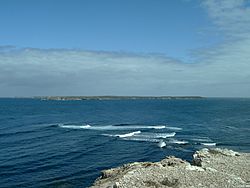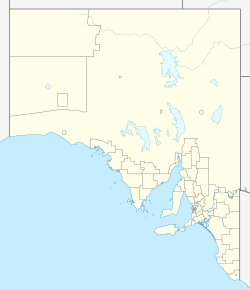Waldegrave Islands facts for kids

Waldegrave Islands as viewed from the nearby coastline
|
|
| Geography | |
|---|---|
| Location | Great Australian Bight |
| Coordinates | 33°35′46″S 134°46′46″E / 33.596°S 134.77934°E |
| Administration | |
|
Australia
|
|
| Demographics | |
| Population | 0 |
The Waldegrave Islands are a group of islands in South Australia. They are found in the Investigator Group, about 2.5 kilometers (1.5 miles) northwest of Cape Finniss. This is on the west coast of the Eyre Peninsula.
The group includes Waldegrave Island, Little Waldegrave Island, and two rocks called the Watchers. These islands are very important because they are a breeding spot for Australian sea lions and Cape Barren geese. The islands have been protected since the 1960s. Since 1972, they have been part of the Waldegrave Islands Conservation Park.
Contents
About the Waldegrave Islands
The Waldegrave Islands are located about 2.5 kilometers (1.5 miles) northwest of Cape Finniss. They are also about 8.5 kilometers (5.3 miles) northwest of the town of Elliston. This area is on the west coast of the Eyre Peninsula in South Australia.
The island group has three main parts:
- Waldegrave Island (sometimes called East Waldegrave Island or East Island).
- Little Waldegrave Island (also known as West Waldegrave Island, West Island, or Seal Island).
- The Watchers, which are two large rocks.
It's easiest to get onto both Waldegrave Island and Little Waldegrave Island from their northern sides. These areas are rocky but are protected from big waves coming from the south.
Waldegrave Island
Waldegrave Island is flat on top with steep sides. It is about 3.5 kilometers (2.2 miles) long from east to west. The highest point on the island is between 37 and 39 meters (121 and 128 feet) high. The island covers an area of about 292 hectares (720 acres).
Its eastern coast is about 1.5 kilometers (0.93 miles) long. At the northeast end is McLachlan Point, and at the south end is Point Watson.
Little Waldegrave Island
Little Waldegrave Island is located about 1 kilometer (0.62 miles) west of Waldegrave Island. Like its larger neighbor, it is flat on top with steep sides. It is about 1 kilometer (0.62 miles) long from east to west.
The highest point on Little Waldegrave Island is about 25 meters (82 feet) high. It has an area of about 32 hectares (79 acres).
The Watchers
The Watchers are two rocks that are about 1 nautical mile (1.9 kilometers) apart. They are located about 1.7 nautical miles (3.1 kilometers) west of Little Waldegrave Island.
The western rock is about 7 meters (23 feet) high. The eastern rock is an intertidal reef, meaning it is covered by water at high tide and exposed at low tide.
How the Islands Were Formed
The Waldegrave Islands were formed about 6,000 years ago. This happened when sea levels rose after the last ice age. The islands are made of a hard, old rock base covered by layers of sand and shell fragments.
Scientists believe the Waldegrave Islands are what's left of a larger land area connected to Cape Finniss. There's even a submerged reef, like an underwater bridge, that connects Waldegrave Island to Cape Finniss. The Watchers are separate rock outcrops.
The water around Waldegrave and Little Waldegrave Islands gets deep quickly. It drops to 15-20 meters (49-66 feet) within 300-1000 meters (980-3,280 feet) of their coasts. The water near the Watchers also drops to about 15 meters (49 feet) deep.
Plants and Animals
Island Plants (Flora)
A study in 1979 on Waldegrave Island found 26 different types of plants. These plants grew in five main groups, including:
- Introduced pasture plants.
- Areas with lots of African Boxthorn (a thorny bush).
- Native shrublands with plants like native juniper and coast daisy-bush.
- Saltbush.
On Little Waldegrave Island, a 1980 study found plants like southern seaheath and sea celery. It also found nine other plant types, including some common weeds like African boxthorn and common iceplant.
Island Animals (Fauna)
Many different animals live on the Waldegrave Islands, especially birds and sea creatures.
Birds
In 1979, a study on Waldegrave Island found many types of birds, such as:
- Short-tailed shearwater
- Cape Barren geese
- Masked plover
- Galah
- White-fronted chat
- Little grassbird
- Australian kestrel
- Black-faced shag
- Sooty oystercatcher
- White-bellied sea eagle
- Various gulls and terns
- Barn owl, which hunts bush rats on the island.
On Little Waldegrave Island, a 1980 study found Australian sea lions and five types of birds. These included rock parrots, Cape Barren geese, and little penguins. More recent studies between 2001 and 2006 confirmed many other bird species, like white-faced herons, peregrine falcons, and Australian ravens.
Australian Sea Lion Reproduction and Life Cycle
Little Waldegrave Island is home to a breeding colony of Australian sea lions. In 1999, there were about 38 sea lions reported here. These amazing animals spend time on land to rest, breed, and raise their pups.
Cape Barren Geese
The Waldegrave Islands are very important for Cape Barren geese. In 1996, it was considered the second most important breeding area for them in South Australia. About 20 pairs of geese nested there. By 1999, the population had grown to about 350 geese. They often stay around the Elliston area in summer, finding food in swamps and even in wheat fields.
Little Penguin Reproduction and Life Cycle
The Waldegrave Islands are also a breeding ground for little penguins. In 1996, about 300 pairs of penguins were reported on Waldegrave Island. By 2006, the population on Waldegrave Island was estimated to be around 600 penguins. They were also common on Little Waldegrave Island in 1979. These small penguins come ashore to nest and raise their young.
History
European Discovery
The Waldegrave Islands were named by Matthew Flinders on February 10, 1802. He named them after William Waldegrave, who was a British naval officer.
Past Uses
Before 1919, people mined guano (bird droppings used as fertilizer) from the Waldegrave Islands. Also, before 1967, Waldegrave Island was used for grazing animals like sheep.
Protected Area Status
The Waldegrave Islands first became a protected area for animals on March 16, 1967. Later, in 1972, the Waldegrave Islands and the Watchers were officially made a conservation park. This means they are protected by law to help keep their unique plants and animals safe.


